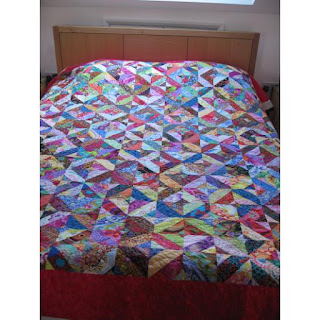Before Christmas I was contacted by a lovely lady called Mary Phenna who is the main fund raiser for the new Hospice which is being built in Cambridge. The old hospice has 12 beds but the new one will have 24 beds and many improved facilities for patients, carers and visitors. Mary asked me if Cambridge Open Studios Artists might help raise money for this project. Of course we would....
The plan is that every participant in Open Studios 2016 will decorate or create a heart to have on display in their studio. Eventually, the hearts will be auctioned to add to the total amount needed to build the new hospice. The new hospice will cost £10.5M and to date £7.7M has been raised.
So, not to hang about, I thought I would make a start on my contribution. My first idea was to make a machine embroidered piece to wrap around the heart template. Then I thought, why not make some sort of piece to hang on a wall. Hence, the plan to make a pin wheel quilt.
So, not to hang about, I thought I would make a start on my contribution. My first idea was to make a machine embroidered piece to wrap around the heart template. Then I thought, why not make some sort of piece to hang on a wall. Hence, the plan to make a pin wheel quilt.
Delving into my fabric collection I found this set of pink fabrics. Perfect! I cut them up into 5 1/2" square, added some white ones then stitched them altogether in a heart shaped arrangement. Sorry the photo is somewhat out of focus. A border in white fabric is added to finish the base.
It's a bit hard to see but on the intersection between the squares I have laid down my 'twister tool'. This is a perspex template with crossing lines in the centre. You then cut out the square very carefully.
This next photo shows the base fabric without the piece I've just cut out. This action is repeated until you have cut out all the squares. The squares are reduced down to 3 1/2" This is a somewhat wasteful technique but the results are worth it.
Phew, tricky cutting!
This is what I'm left with! Might save all the small squares.........
Here, I've laid out all the small squares in order. Each one is turned a few degrees to the right. You must be careful doing this otherwise you can end up with no clue where they all go!
So, row by row, you stitch all the small squares together. I used my very ancient Singer machine which was a gift from my parents in 1974. It turns out it does a perfect 1/4" seam with the normal presser foot. Nothing special required.
And a close up
Eventually, they are all stitched up then each row is put together and a border added.
I then went onto do the quilting. I decided to quilt the centre heart area in pink thread with an open vermicelli free machined line. The white areas were quilted with white thread but with denser stitching.
Here is my finished piece. It's about 24" square. It does not have the usual binding as I decided to finish each edge with a facing. I will explain how to do a facing in my next blog posting.
I'm quite pleased with the end result. Come and see it in person during Cambridge Open Studios this July.
I couldn't end this blog posting without a photo of my trusty old Singer. it still works as good as the day mum and dad bought it for me.







































